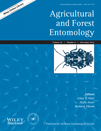Ver ítem
- xmlui.general.dspace_homeCentros e Institutos de InvestigaciónCICVyA. Centro de Investigación en Ciencias Veterinarias y AgronómicasInstituto de GenéticaArtículos científicosxmlui.ArtifactBrowser.ItemViewer.trail
- Inicio
- Centros e Institutos de Investigación
- CICVyA. Centro de Investigación en Ciencias Veterinarias y Agronómicas
- Instituto de Genética
- Artículos científicos
- Ver ítem
Patterns of resource distribution among conspecific larvae in two fruit fly species : Anastrepha fraterculus and Ceratitis capitata (diptera: tephritidae)
Resumen
1 Anastrepha fraterculus (Diptera: Tephritidae) and Ceratitis capitata (Diptera: Tephritidae) are fruit fly pests whose larvae are frequently found sharing the same fruit with conspecifics. Because larvae are incapable of leaving the fruit in search of non-infested fruit, they are forced to share nutritional resources and eventually compete with other larvae for these.
2 In the present study, we investigated the effect of intraspecific competition on the
[ver mas...]
1 Anastrepha fraterculus (Diptera: Tephritidae) and Ceratitis capitata (Diptera: Tephritidae) are fruit fly pests whose larvae are frequently found sharing the same fruit with conspecifics. Because larvae are incapable of leaving the fruit in search of non-infested fruit, they are forced to share nutritional resources and eventually compete with other larvae for these.
2 In the present study, we investigated the effect of intraspecific competition on the development of A. fraterculus and C. capitata larvae, and compared the strategies adopted by these species.
3 To this end, newly-hatched larvae were transferred into a container with a fixed amount of larval diet at increasing larval densities and several developmental parameters were measured.
4 The two species showed similarities and differences in the way in which they
responded to an increasing density. In A. fraterculus, pupal weight and the duration of the larval stage decreased as the competition levels increased. Larvae of C. capitata showed a consistent reduction in pupal weight and larval survival as the larval density increased. In A. fraterculus, the reduction in pupal weight was heterogeneous, with most pupae showing a marked decrease in weight and only few pupae showing slight negative effects or no effect at all, whereas, in C. capitata, the reduction was similar for all pupae.
5 The differences in the way in which these species responded to competition suggest that there are different patterns of resource distribution among conspecific larvae. The implications of these findings for oviposition behaviour and the life history of the two species are discussed.
[Cerrar]

Fuente
Agricultural and forest entomology 18 (4) : 349–356. (November 2016)
Fecha
2016
ISSN
1461-9555 (Print)
1461-9563 (Online)
1461-9563 (Online)
Formato
pdf
Tipo de documento
article
Palabras Claves
Derechos de acceso
Restringido
 Excepto donde se diga explicitamente, este item se publica bajo la siguiente descripción: Creative Commons Attribution-NonCommercial-ShareAlike 2.5 Unported (CC BY-NC-SA 2.5)
Excepto donde se diga explicitamente, este item se publica bajo la siguiente descripción: Creative Commons Attribution-NonCommercial-ShareAlike 2.5 Unported (CC BY-NC-SA 2.5)

